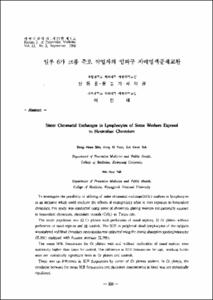KUMEL Repository
1. Journal Papers (연구논문)
1. School of Medicine (의과대학)
Dept. of Preventive Medicine (예방의학)
일부 6가 크롬 폭로 작업자의 임파구 자매염색분체교환
- Keimyung Author(s)
- Shin, Dong Hoon; Yoon, Nung Ki; Suh, Suk Kwon
- Department
- Dept. of Preventive Medicine (예방의학)
- Journal Title
- 예방의학회지
- Issued Date
- 1990
- Volume
- 23
- Issue
- 3
- Abstract
- To investigate the possibility of utilizing of sister chromatid exchange(SCE) analysis in lymphocytes as an indicator which could evaluate the effects of mutagenicity after in vivo exposure to hexavalent chromium, this study was conducted using some of chromium plating workers occupationally exposed to hexavalent chromium, chromium trioxide ( CrO 3 CrO3 ) in Taegu city. The study population was 12 Cr platers with perforation of nasal septum, 12 Cr platers without perforation of nasal septum and 20 controls. The SCE in peripheral blood lymphocytes of the subjects was analyzed and blood chromium concentration was estimated using the atomic absorption spectrophotometer (IL551) equipped with furnace atomizer (IL755). The mean SCE frequencies for Cr platers with and without perforation of nasal septum were statistically higher than those for control. The difference in SCE frequencies by age, smoking habits were not statistically significant both in Cr platers and controls. There was no difference in SCE frequencies by career of Cr platers workers. In Cr platers, the correlation between the mean SCE frequencies and chromium concentration in blood was not statistically significant. Using the transformation y=(sumSCE) 12 +(sumSCE+1) 12 y=(sumSCE)12+(sumSCE+1)12 , when the data was studied by multiple regression, it appeared that the influence of the occupation was the most important. Age, smoking, occupation and CrB(blood chromium concentration) together explain only 32.3% of interpersonal variation on SCE. The results in this study suggest tt a genetic risk due to occupationally exposure to hexavalent chromium is clearly inferable and thus, SCE analysis in human lymphocytes may be used indicator of biological toxic effects of chromium. Further, populatio analysis stuies are required before SCE frequency can be used as a mutagenic indicator in human population.
1989년 11월부터 4개월간 대구시내 소재 일부, 6가 크롬(삼산화크롬)으로 피막처리하는 도금작업장의 남성근로자를 대상으로 비중격천공이 있는 근로자 12명과 비중격천공이 없는 근로자 12명을 폭로군으로 하고 크롬에 폭로된 적이 없는 정상인 20명을 대조군으로 하여 개별면담을 통해 연령, 직업력, 흡연습관을 파악하였으며, 정맥혈을 채취하여 원자화 무염광로를 부착한 원자흡광도계로 혈중 크롬농도를 측정하였으며 말초혈액 중 임파구의 자매염색분체교환의 발현빈도를 조사하고 연령, 흡연습관, 직업력 및 혈중 크롬농도 등이 임파구 자매염색분체교환의 발현빈도에 미치는 영향을 조사했다. 크롬 도금작업의 말초혈액 중 임파구 자매염색분체교환의 발현빈도는 비중격 천공이 있는 군이 $10.1{\pm}1.6$, 비중격천공이 없는 군이 $8.5{\pm}3.4$이었고 대조군 $6.1{\pm}2.1$으로 세군간에 유의한 차이가 있었으며 (p<0.01), 비중격천공 군에서 가장 높은 빈도를 보였으며, 대조군에 비해 1.7배의 높은 빈도를 나타냈다. 혈중 크롬농도는 대조군이 $0.060{\pm}0.043{\mu}g/ml$, 크롬도금 작업자 중 비중격천공이 있는 군 $0.114{\pm}0.030{\mu}g/ml$, 비중격천공이 없는 군 $0.090{\pm}0.050{\mu}g/ml$로 세군간의 차이는 유의하였다 (p<0.01). 크롬도금 작업자와 대조군 모두 연령군별, 흡연습관별 및 근속년수에 따른 자매염색분체교환의 발현빈도에는 유의한 차이가 없었다. 혈중 크롬농도와 자매염색분체교환 발현빈도의 상관성은 상관계수, r=0.007로서 상관관계가 없었다 (Y=0.638 X+0.191, r=0.007. p>0.05). SCE 평균 발현빈도를 $y=(sum\;SCE)^{\frac{1}{2}}+(sum\;SCE+1)^{\frac{1}{2}}$를 이용하여 변형한 변수 y에 대해 연령, 흡연습관, 직업 및 혈중 크롬농도의 요인들로서 설명력은 32.3%였으며 가장 중요한 변수는 직업으로 나타났다. 이상의 결과로 보아 직업적인 크롬폭로에 의한 유전적 손상의 위험성이 어느 정토 있을 것으로 추측되며 생물학적 독성검정 지표로서 유용성이 있을 것으로 생각된다.
- Alternative Title
- Sister Chromatid Exchanges in Lymphocytes of Some Workers Exposed to Hexavalent Chromium
- Publisher
- School of Medicine
- Citation
- 신동훈 et al. (1990). 일부 6가 크롬 폭로 작업자의 임파구 자매염색분체교환. 예방의학회지, 23(3), 358–368.
- Type
- Article
- ISSN
- 0254-5985
- Appears in Collections:
- 1. School of Medicine (의과대학) > Dept. of Preventive Medicine (예방의학)
- 파일 목록
-
-
Download
 oak-bbb-4805.pdf
기타 데이터 / 589.36 kB / Adobe PDF
oak-bbb-4805.pdf
기타 데이터 / 589.36 kB / Adobe PDF
-
Items in Repository are protected by copyright, with all rights reserved, unless otherwise indicated.